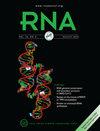Contribution of an alternative 16S rRNA helix to biogenesis of the 30S subunit of the ribosome
IF 4.2
3区 生物学
Q2 BIOCHEMISTRY & MOLECULAR BIOLOGY
引用次数: 0
Abstract
30S subunits become inactive upon exposure to low Mg2+ concentration, due to a reversible conformational change that entails nucleotides (nt) in the neck helix (h28) and 3’ tail of 16S rRNA. This active-to-inactive transition involves partial unwinding of h28 and re-pairing of nt 921-923 with nt 1532-1534, which requires flipping of the 3’ tail by ~180 degrees. Growing evidence suggests that immature 30S particles adopt the inactive conformation in the cell, and transition to the active state occurs at a late stage of maturation. Here, we target nucleotides that form the alternative helix (hALT) of the inactive state. Using an orthogonal ribosome system, we find that disruption of hALT decreases translation activity in the cell modestly, by ~2-fold, without compromising ribosome fidelity. Ribosomes carrying substitutions at positions 1532-1533 support growth of E. coli strain Δ7 prrn (which carries a single rRNA operon), albeit at rates 10-20% slower than wild-type ribosomes. These mutant Δ7 prrn strains accumulate free 30S particles and precursor 17S rRNA, indicative of biogenesis defects. Analysis of purified control and mutant subunits suggests that hALT stabilizes the inactive state by 1.2 kcal/mol with little-to-no impact on the active state or the transition state of conversion.另一种 16S rRNA 螺旋对核糖体 30S 亚基生物形成的贡献
由于 16S rRNA 颈部螺旋(h28)和 3'尾部的核苷酸(nt)发生了可逆的构象变化,30S 亚基在暴露于低 Mg2+ 浓度时失去活性。这种活性到非活性的转变涉及 h28 的部分松开和 nt 921-923 与 nt 1532-1534 的重新配对,这需要将 3' 尾部翻转约 180 度。越来越多的证据表明,未成熟的 30S 颗粒在细胞中采用非活性构象,而向活性状态的转变发生在成熟的晚期。在这里,我们以形成非活性态替代螺旋(hALT)的核苷酸为目标。通过使用正交核糖体系统,我们发现 hALT 的破坏会适度降低细胞内的翻译活性,降低幅度约为 2 倍,而不会影响核糖体的保真度。携带 1532-1533 位置换位的核糖体支持大肠杆菌菌株 Δ7 prrn(携带单个 rRNA 操作子)的生长,尽管生长速度比野生型核糖体慢 10-20%。这些突变型 Δ7 prrn 菌株积累了游离的 30S 颗粒和前体 17S rRNA,表明存在生物发生缺陷。对纯化的对照亚基和突变亚基的分析表明,hALT 可使非活性状态稳定 1.2 千卡/摩尔,而对活性状态或转换的过渡状态几乎没有影响。
本文章由计算机程序翻译,如有差异,请以英文原文为准。
求助全文
约1分钟内获得全文
求助全文
来源期刊

RNA
生物-生化与分子生物学
CiteScore
8.30
自引率
2.20%
发文量
101
审稿时长
2.6 months
期刊介绍:
RNA is a monthly journal which provides rapid publication of significant original research in all areas of RNA structure and function in eukaryotic, prokaryotic, and viral systems. It covers a broad range of subjects in RNA research, including: structural analysis by biochemical or biophysical means; mRNA structure, function and biogenesis; alternative processing: cis-acting elements and trans-acting factors; ribosome structure and function; translational control; RNA catalysis; tRNA structure, function, biogenesis and identity; RNA editing; rRNA structure, function and biogenesis; RNA transport and localization; regulatory RNAs; large and small RNP structure, function and biogenesis; viral RNA metabolism; RNA stability and turnover; in vitro evolution; and RNA chemistry.
 求助内容:
求助内容: 应助结果提醒方式:
应助结果提醒方式:


